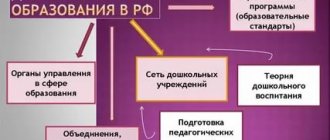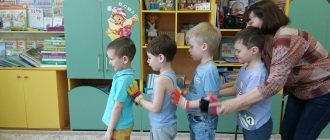Examples of original programs
Name of the lesson:
Building with Lego
Novelty
- Introduction of the latest information technologies into the educational process.
- Development of sensory skills in the intellect of pupils, realized in motor games.
Relevance
- Such construction opens up the world of technology more widely for older preschool children than other types of activities;
- Prepares the ground for children's technical abilities;
- Activates mental and speech activity, communication skills, imagination of babies, develops cognitive activity and broadens horizons.
Goals and objectives
- Development of technical creativity in children.
- Developing interest in design.
- Learning to analyze the main parts of an object’s structure and the concept of their functional purpose.
- Development of fine motor skills, attention and memory.
- Improving communication skills when working with a couple.
Name of the lesson:
List of variative preschool education programs with brief annotations
List of variative preschool education programs with brief annotations
“Harmony of Development” (D. I. Vorobyova);
The main idea of the program involves:
- comprehensive, harmonious development of a child 2-7 years old;
-preservation and strengthening of physical and mental health;
-equal development of the intellectual, emotional and moral-volitional spheres of the individual;
-creating the necessary conditions for the full development of the creative potential of the child and teacher.
The program allows you to solve problems:
-knowledge of the world and oneself in it through the discovery of properties (phenomena), qualities, attributes of objects and experimentation with them;
-development of the ability to empathize, sympathize, communicate with living and inanimate objects;
-perception, thinking, memory, imagination, fantasy, the ability to purposefully engage in the creative process.
The program content is divided into five blocks.
1. Real objects of the world (living and inanimate nature, humans, animals, plants, buildings, transport).
2. Second nature (artistic images - painting, graphics, sculpture, architecture, decorative and applied arts).
3. Sound art (music, poetry, prose, folklore).
4. Sports-motor, plastic and theatrical-game activities (pantomime, sports and didactic games, dramatization).
5. Actually productive visual activity (drawing, appliqué, modeling, design).
“Kindergarten is a house of joy” (N. M. Krylova),
The objectives of the program are: caring for the health of the child and promoting the enrichment of the mental and physical development of each child; facilitating the child’s mastery of various types of activities at the level of independence and the development of his creative potential; assistance in mastering the basics of spiritual culture.
Structural and content characteristics
The authors prefer to call “Kindergarten - a home of joy” not a program, but a scientific and methodological system. In the traditional sense, the program is included in this system only as one part. The second part is “Technology”, a detailed project for introducing the program into practice. The third is what we call innovation, the conditions that need to be provided for educators to master technology.
Features of organizing the work of pre-school specialists
The authors of the “Kindergarten – House of Joy” program believe that the most difficult thing for a teacher is to establish trusting contacts with a child. Technology (drama, original work, etc.) frees up time and opens up the opportunity for creativity with children, allows you to look for your unique style of professional activity, your own style of interpreting the proposed events.
The metaphor “Ladder of Success” denotes the activities of a teacher that contribute to the enrichment of a child’s development. The four steps of the ladder correspond to the four levels of mastery of activity (recognition, reproduction under guidance, independence, creativity).
Educational and methodological support
In the “Kindergarten - House of Joy” program, the idea was realized to provide the teacher with detailed auxiliary material. The technology is described in 34 books and includes not only daily, but also hourly, and even minute-by-minute organization of the entire life and activity of a whole same-age group of 20-25 children during a 10-12-hour work schedule.
“Childhood” (V. I. Loginova, T. I. Babaeva, etc.);
Goal: ensuring the development of the child during preschool childhood: intellectual, physical, emotional, moral, volitional, social and personal. The introduction of a child into the world around him is carried out through his interaction with various spheres of existence (the world of people, nature, etc.) and culture (fine arts, music, children's literature and native language, mathematics, etc.). The program presents works of oral folk art, folk games, music and dance, and decorative and applied arts of Russia. The teacher is given the right to independently determine the schedule of classes, content, method of organization and place in the daily routine. The program highlights a new important section: “The child’s attitude towards himself” (self-knowledge). “Childhood” is a comprehensive educational program developed by the authors from the standpoint of humanistic pedagogy, a personal-activity approach to the development and upbringing of a preschool child. It includes three parts in accordance with the three stages of the preschool period (junior, middle, senior preschool age). Each part is based on general ideas that reflect the authors’ views on preschool childhood, its importance in human life, and the conditions for effective development in the preschool years. The intellectual, physical, emotional, moral, volitional, social and personal development of the preschooler takes place in the activities that are closest and most natural to the child. The entire content of the program is conventionally united around four main blocks: “Cognition”, “Humanite attitude”, “Creation”, “Healthy lifestyle”. For example, the “Humane attitude” block orients children towards a friendly, careful, caring attitude towards the world; The purpose of the “Cognition” block is to help preschoolers master a variety of accessible ways of understanding the world around them (comparison, elementary analysis, generalization, etc.). Particular emphasis in the program is placed on introducing children to the natural world and instilling a caring attitude towards natural objects. The program has a complete set of methodological support.
“Golden Key” (G. G. Kravtsov and others);
The “Golden Key” program is a comprehensive development program for children from 3 to 10 years old, developed by G. G. Kravtsov, E. E. Kravtsova, E. L. Berezhkovskaya and others. The goal of P. is to achieve an organic unity of conditions that provide children with the most complete , age-appropriate development, emotional well-being. P. is a model of lifelong education for children, which provides for groups of different ages (2-4 years, 5-7 years, 8-10 years), the predominance of individual forms of work with children, the formation of a system of relationships based on the type of family relationships, and an emphasis on the development of play activity and emotional-volitional sphere of preschool children.
“Origins” (edited by L. E. Kurneshova),
Program "Origins". This program holistically defines the content and nature of the modern pedagogical process, aimed at developing the basis of the personal culture of a preschool child. It implements the most important principle of humanistic pedagogy - dialogue between an adult and a child, children among themselves, teachers with each other, and a teacher with parents. The “Origins” program reflects the enduring importance of preschool childhood as an extremely important, basic period for subsequent human development. The basis of the program is the concept of psychological age as a stage of child development, which has its own structure and dynamics, as well as the scientific position of A.V. Zaporozhets on the amplification (enrichment) of child development, the relationship of all its aspects.
The main goal of the program is the formation of a well-rounded personality from birth to 7 years of age, its universal, including creative, abilities to a level corresponding to the age capabilities of the child; ensuring every child has an equal start in development; maintaining and promoting health.
In accordance with this approach, the program identifies the following age stages: early childhood - infancy (up to one year); early age (from one year to three years); preschool childhood: junior preschool age (from three to five years) and senior (from five to seven years). This age periodization, according to the authors, allows us to see both the most general trends and the individual development perspective of each child.
The program is built in accordance with the didactic principles of education, training and development of preschool children. For each age stage, the program identifies four leading lines of development: social, cognitive, aesthetic and physical; the features of the development of these lines in infancy, early, junior and senior preschool age are revealed; a hierarchy of main types of activity is set (communication, objective activity, game). The program gives a special place to play activity as the main one in the development of the personality of a preschool child. The game permeates all structural components of the program and its content as a whole.
The program contains new, independent sections: “Health”, “Speech and speech development”, “The world in which we live”, “Nature and the child”, “Culture of everyday life” and others, which significantly complement and enrich it.
“Little thing” (G. G. Grigorieva, E. G. Kravtsova, etc.);
The goal of the program is the comprehensive development, education and training of children under three years of age.
A program has been developed in the spirit of the ideas of humanizing family and public education of young children. The program provides a multi-level, individually differentiated approach to the child.
Child upbringing and development programs are presented in dialectical unity and interconnection. At the same time, the indicative nature of their content and the need to take into account the individual pace, level and direction of the child’s development are emphasized.
The program is built on the principles of a systematic and activity-based approach, and is presented in four blocks: prenatal pedagogy; characteristics of the physical and mental development of a child from birth to three years; development and education of children in the first year of life; development and upbringing of a child in the second and third year of life.
The program contains information materials on all areas of personality development of a child under three years of age, as well as methodological recommendations. It includes a selection of textbook materials (literary works) for reading and telling them to children, multifunctional reference materials and a list of methodological literature. The appendices provide tables of development levels and achievements of children in each age period, as well as literary material and approximate scenarios for family holidays.
“Fundamentals of the safety of preschool children” (Authors: R. B. Sterkina, O. L. Knyazeva, N. N. Avdeeva).
Goal: to develop the child’s skills of adequate behavior in various unexpected situations, independence and responsibility for their behavior. The program involves solving the most important social and pedagogical problem - developing in a child the skills of adequate behavior in various unexpected situations.
The content includes six sections: “Child and other people”, “Child and nature”, “Child at home”, “Child’s health”, “Child’s emotional well-being”, “Child on the city streets”. When implementing this program, each preschool institution organizes education taking into account the individual and age characteristics of children, sociocultural differences, and the uniqueness of home and living conditions in urban and rural areas. The program has an educational and methodological set: a textbook on the basics of life safety for children of senior preschool age and four colorfully illustrated handout albums for children.
“Development” (edited by O. M. Dyachenko).
The program was based on the idea of A.V. Zaporozhets about the intrinsic value of the preschool period of development and L.A. Wenger’s concept of the development of abilities.
The program requires the establishment of a person-centered model of education and training. The program is compiled for each age and contains an explanatory note and a detailed description of working with children.
Goals: development of children's mental and artistic abilities, as well as the development of specific preschool activities.
The methods of preschool education have been radically changed - children are given a system of successively more complex tasks. The main emphasis of the program is not on what factual material is given to children, but on how it is given. When developing program material, we first took into account what means of solving cognitive and creative problems should be learned by children, and on what content these means can be learned most effectively.
In the younger group, the main means are sensory standards (the so-called “impact” section - the development of sensory culture); in the middle - visual models of spatial relationships such as a plan or drawing (formation of spatial relationships); in older preschool age, the central place is occupied by conditionally symbolic visual models reflecting quantitative relationships, relationships of sounds in a word, the relationship of natural phenomena, the relationship between the content and scope of concepts (mathematics, literacy, ecology, logic).
In the structure of the educational process organized under the Development program:
1. Development of sensory abilities (younger age).
2. Speech development and familiarization with fiction.
3. Introduction to literacy (junior, middle groups); preparation for literacy training (from the senior group).
4. Formation of ideas about the surrounding world about oneself (younger age).
5. Familiarization with nature (middle group).
6. Formation of elementary environmental ideas.
7. Development of elements of logical thinking (from the senior group).
8. Formation of elementary mathematical concepts (from the middle group).
9. Familiarization with spatial relationships (from the middle group).
10. Constructive activity.
11. Visual activity.
12. Game activity.
Contents of the author's methods
What is the essence of copyright programs?
- Creating conditions in kindergarten for the comprehensive development of the child.
- Development of children's personal motivation for creativity and cognition.
- Providing joy and fun for little ones.
- Introducing pupils to human values.
- Prevention of social behavior.
- Creating conditions for children's creative self-realization.
- Unity in the mental, physical and spiritual development of children.
- Strengthening both physical and mental development.
- Communication between the teacher and the child’s family members.
Innovation programs
What working, innovative methodology can be drawn up? Based on the author's development, you can choose many interesting topics in ecology, physical education, art, drawing and other disciplines.
The initial basis for the development of the author’s program is a standard educational program, which sets the basic parameters of the skills that children must master. Therefore, when creating his own program, a teacher needs to build on this minimum and deepen, expand, and specify it. At the same time, educators need to remember that they cannot build a methodology below this minimum level.
Intentions, differences of the program
So, we have found out that your own program is created by the teacher or team. It belongs to him or them as intellectual property. Its goal is to solve a specific problem in additional education and achieve its diversity.
You may ask, what are the differences between the author’s methodology and the educational one? The first is created by the teacher himself:
- according to personal intention, taking into account the experience of working with the guys;
- based on experience;
- teacher's skill level;
- developed programs;
- the teacher’s vision of problem solving.
In your own methodology it is necessary to provide an original approach and the necessary novelty.
Literature
Before moving on to this topic, let's see what literature is offered on various sites.
- Here you can get coupons that give you the right to participate offline in webinars on the topic of the teacher’s work program.
- Do you want to purchase a kit with a book and a disk about drawing up the basic educational program of a preschool educational institution? Then come here.
- To get acquainted with the development of a teacher’s work program on a CD for a computer, go here.
- Would you like to take a look at the pedagogical video workshop for the main educational program of the preschool educational institution? Then this is the place for you.




